Almost everyone has heard of the Camino de Santiago? But did you know that you can also walk an ancient pilgrimage route in Italy? The Via Francigena was one of the most popular pilgrimage routes in the Middle Ages, starting in Canterbury in England and running through four countries to the Vatican in Rome. But of course you can also walk parts of it. I myself walked the last 110 kilometers from Viterbo to the Vatican in Rome, to enjoy Italian landscapes, medieval towns and the delicious Italian cuisine. And I have to admit, there is hardly a more unique way to reach Rome. In this article you will read everything you want to know about the Via Francigena route – stage 16 – from Viterbo to Rome and how to best make this trip.

The Via Francigena is a historic pilgrimage route of almost 3,000 kilometers long that runs from Canterbury in England, through France and Switzerland to Rome and then on to Apulia in Italy. The path led pilgrims not only to the Holy City and the tombs of the apostles Peter and Paul but also to Santa Maria di Leuca and other coastal towns of Apulia, where the embarkation ports for the Holy Land were located. The route was formalised in the 10th century by the Archbishop of Canterbury, Sigeric the Serious, after he had been consecrated a cardinal by Pope John XV. He returned to his home city from Rome and described the stages of his journey in a diary.
And although the popularity of the Via Francigena cannot be compared to the Camino de Santiago, it has been attracting more and more people who want to make the walk to Rome. The Via Francigena has even been declared a European Cultural Route by the Council of Europe and is an important cultural heritage.
The Via Francigena route, from Canterbury to Rome, consists of 2030km and 16 stages. Do you want to walk the entire pilgrimage route? Then you should count on 100 days and possibly even longer if you want to walk to the coast of Apulia. But it is just as nice and also more accessible to walk a part, such as the route from Viterbo to Rome, or perhaps several stages. Because the Via Francigena runs through different countries, each with its own highlights and challenges, choosing a route can be a challenge.
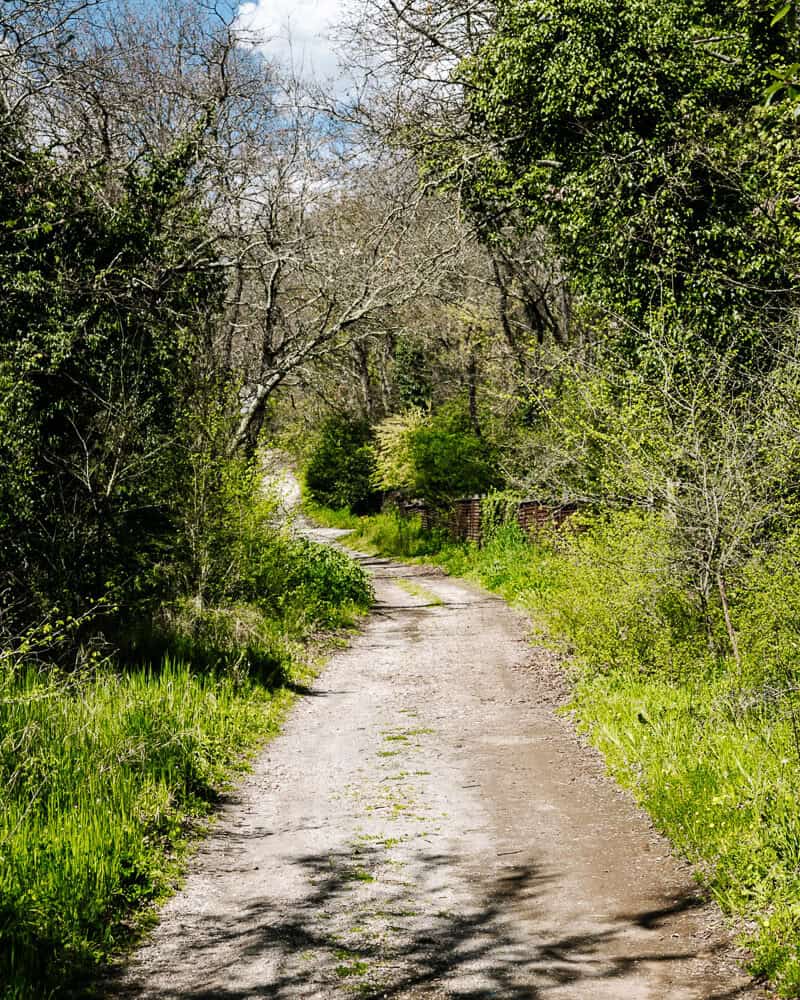
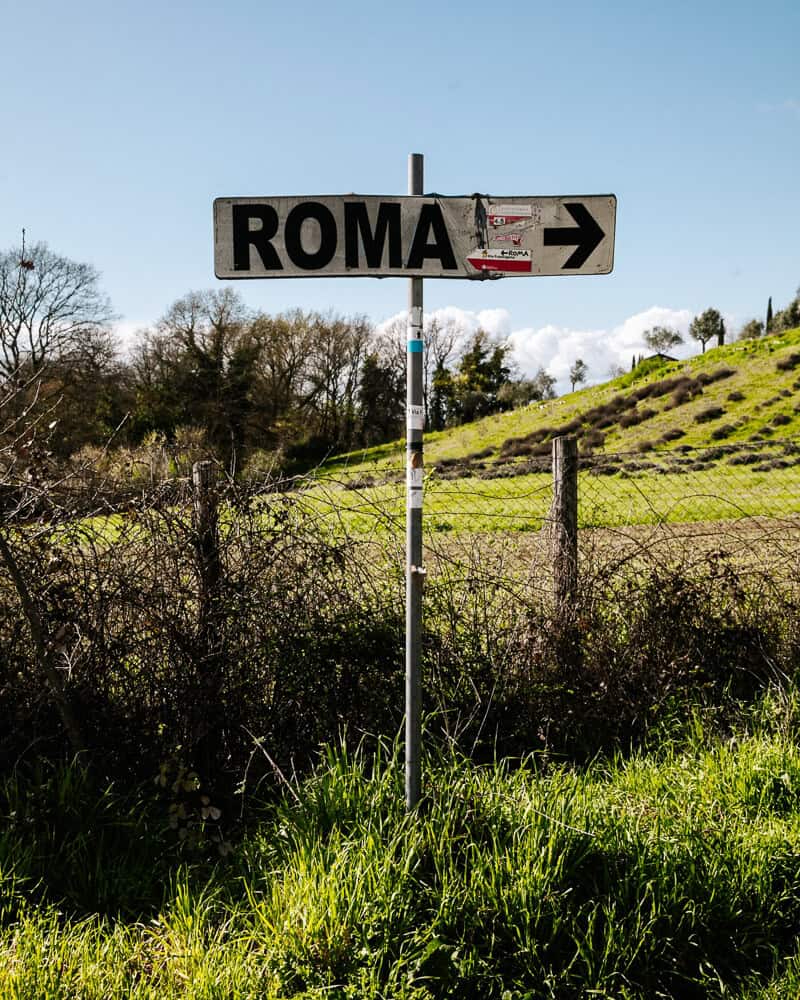
And that’s where the expert organization and planner Follow the Camino comes in. Of course, you need to think about how much time you have and what you want to see along the way. But Follow the Camino helps you plan a custom route, books accommodations, meals, a luggage service, and gives you many tips and tricks for preparation. For me it was an easy choice, because I wanted to walk through Italy and Rome is one of my favorite cities, but there are countless possibilities. In this article, I’ll tell you everything you need to know about walking the Via Francigena route from Viterbo to Rome.
Curious about the different Via Francigena routes? Be sure to check out the Follow the Camino website. Here, you’ll quickly get an idea of the numerous possibilities.
During Stage 16 of the Camino Via Francigena route you will cover approximately 110 kilometers in five days. Every day is different, but on average you should count on approximately 24 kilometers per day. Given the relatively easy path, without many ascents and descents, it is doable for anyone who likes walking and has a normal lecel of fitness.
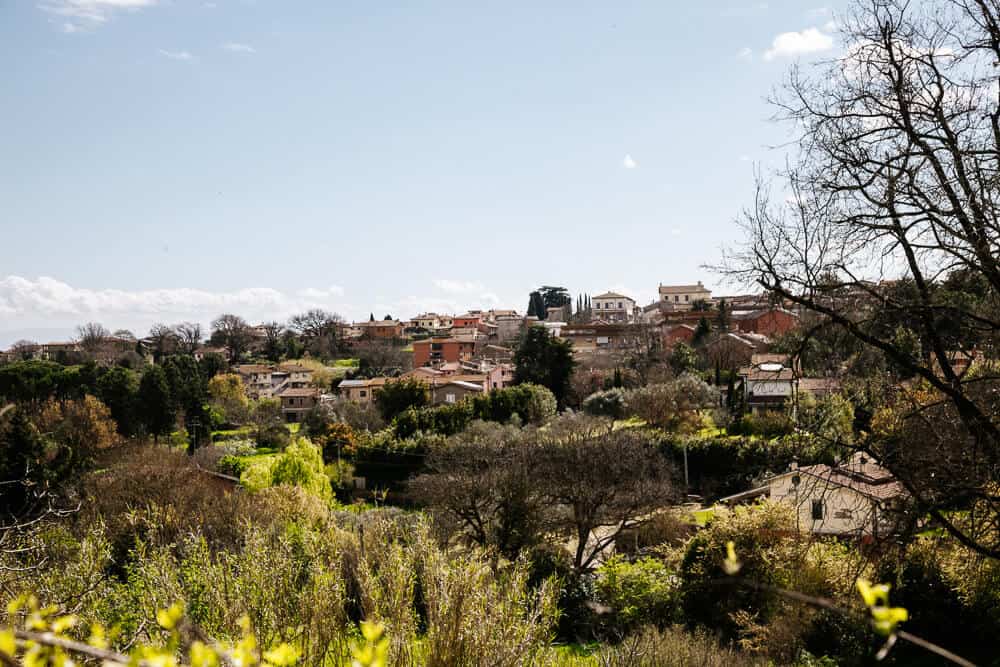
This is also, just like with the last stage of the Camino Frances during the Camino de Santiago, the minimum distance you have to walk to qualify for an official pilgrim certificate. Upon arrival, you will receive a special pilgrim passport in which you collect stamps during your Camino Francigena. And this is needed at the end to obtain the certificate in the St. Peters Church. And even though this is not the most important thing, I can personally say that the proof of a successfully completed pilgrimage tto Rome gives you more satisfaction than you might initially think– I’ll explain later.
Do you want to walk the last stage of the Via Francigena route? Then you start in Viterbo and spend the night in different places along the way until you reach Rome. If you arrange this through Follow the Camino, you’ll stay in hotels, with the option of a three-course menu included. Moreover you have your luggage transported daily. Curious? Below you will find my experiences and a day-to-day description during the Via Francigena route – stage 16 – from Viterbo to Rome.
Because we are walking the last 110 kilometers of the Camino Via Francigena, we start in Viterbo, a medieval town, about an hour’s drive from Rome airport. It is recommended to take an early flight, so that you have enough time to prepare the walk and also experience something of Viterbo.
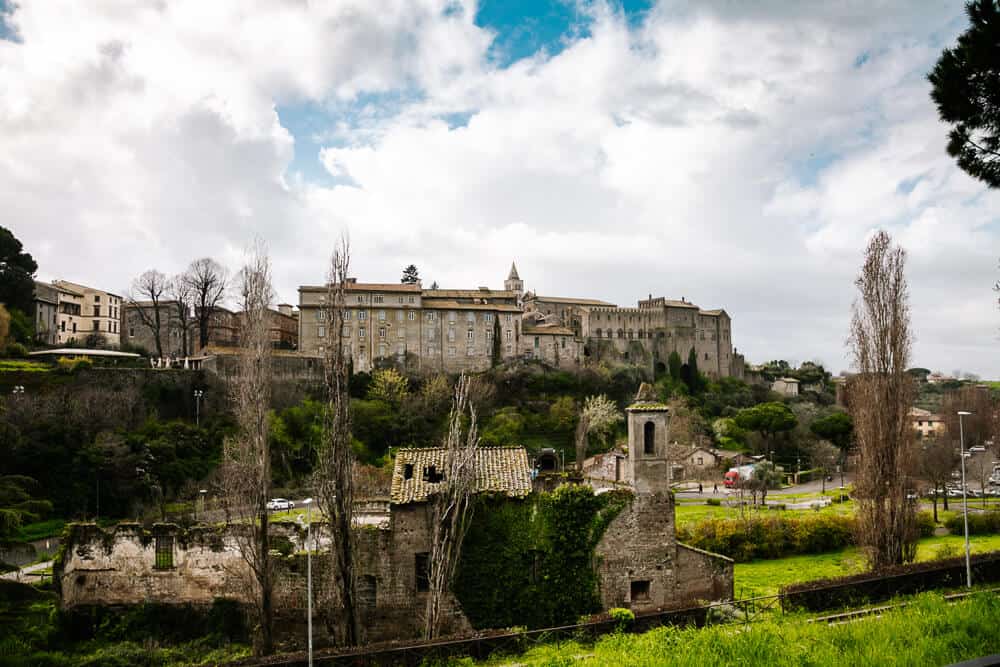
Because we hiked the Camino Frances, part of the Camino de Santiago, last year, we are a little less nervous, but it is still exciting. How hard is it going to be? Is this Via Francigena route easy to find? We leave our luggage at the reception, put the first stamp in our pilgrim passport and set off with the instructions from the hotel. The first part leads through Viterbo. Yesterday there was little time to explore the town, so it is nice to see the historic center in daylight, because of is architecture and medieval atmosphere.

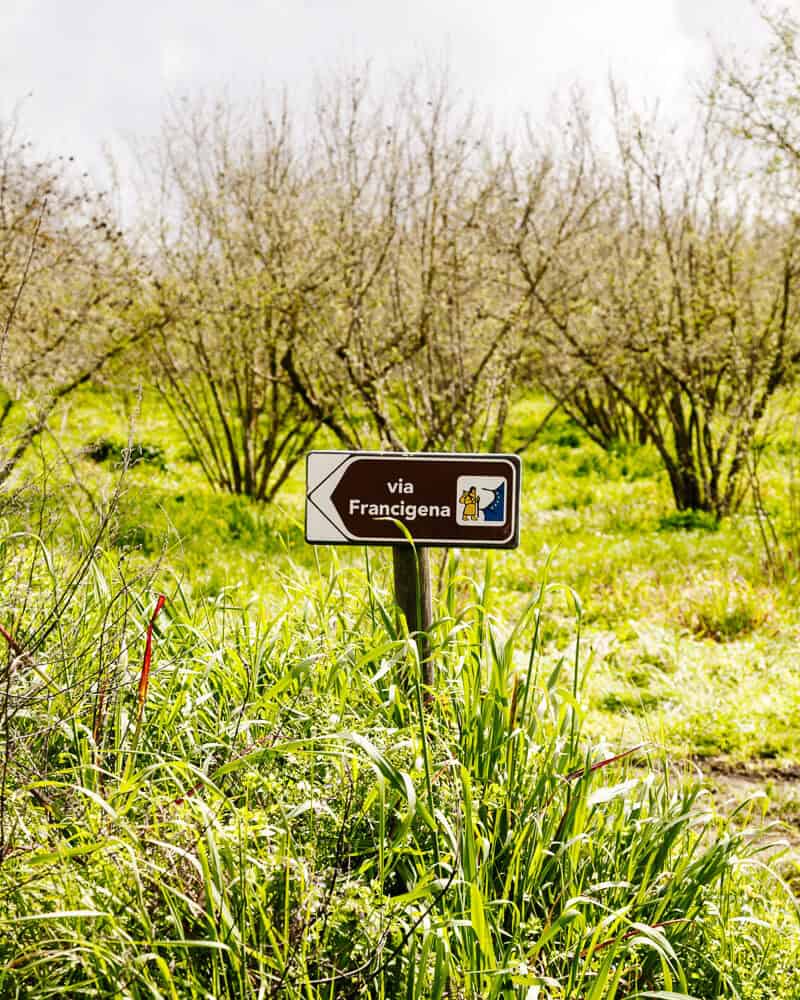
We soon see a sign with Via Francigena route and that reassures us. Unfortunately we immediately get lost, because we followed a recommendation for a small detour. Some locals quickly send us back to the trail, and we do not make too many extra kilometers. After an hour of walking we also learn that there are dozens of different Via Francigena signs; colors, arrows, drawings, stamps and this can be a sticker, graffiti or painting in a tree. I’ve never seen so many variations before, meaning you definitely have to pay attention in the beginning.
We walk a beautiful route over winding paths, through fields with olive trees and here and there a farm with people working in the fields. Because it is spring, everything is in bloom and the birds are whistling. It is quiet and we seem to be the only Via Francigena walkers. Something that is confirmed when we stop at the local church for a stamp.

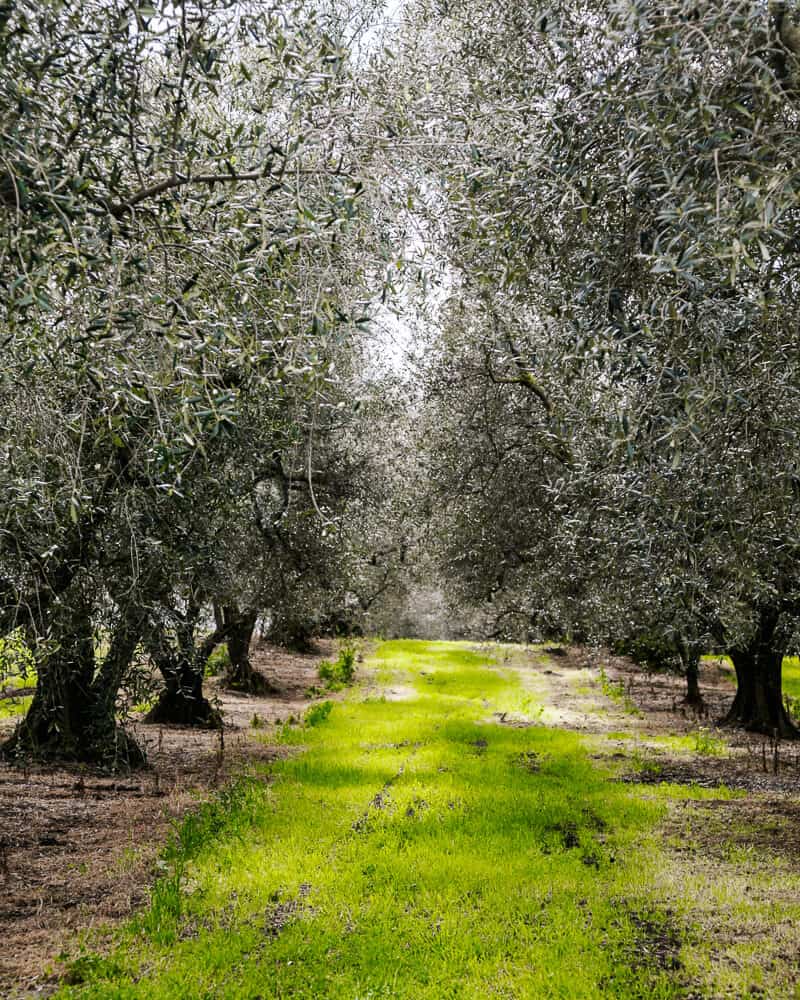
The priest tells us that we are the third walkers of the day and is curious where we come from and how we came up with the idea to walk this pilgrimage route to Rome. We are offered coffee and biscuits and when the church closes for the rest of the day, we continue along fields and viewpoints. There are no restaurants along the way so we look for a place to picknick. Something that we will do more oftten the next coming days.
We also get some special attention in the church Chiesa di Santa Maria in Foro Cassio, near Vetralla. We are offered water and fruits and a private tour in Italian. Before continue our way to Vetralla, we have our picture taken and leave a stone with our names behind.
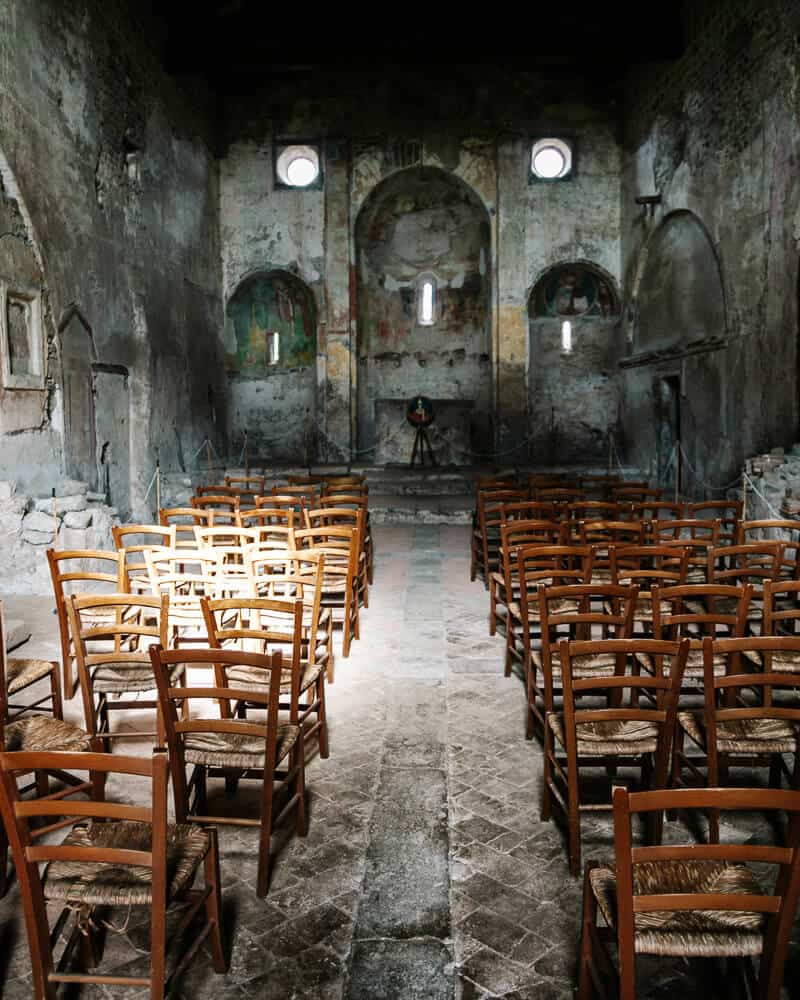
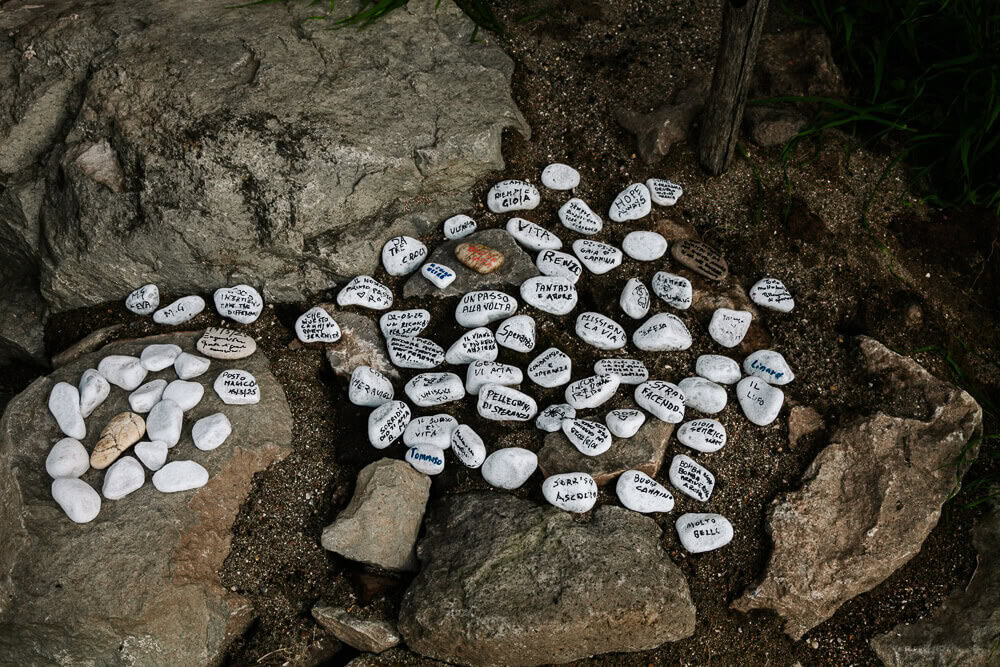
Vetralla is a small municipality in the Italian province of Viterbo. In several places there are signs and murals about the Via Francigena, making us realize again how important this pilgrimage route to Rome must have been in the past. The old center is truly stunning. As if you have stepped back into the Middle Ages. Here too, we are quickly approached by an older Italian man, asking if we want to see the most beautiful viewpoint. And of course, we do. We walk through some alleys and end up at lovely places.
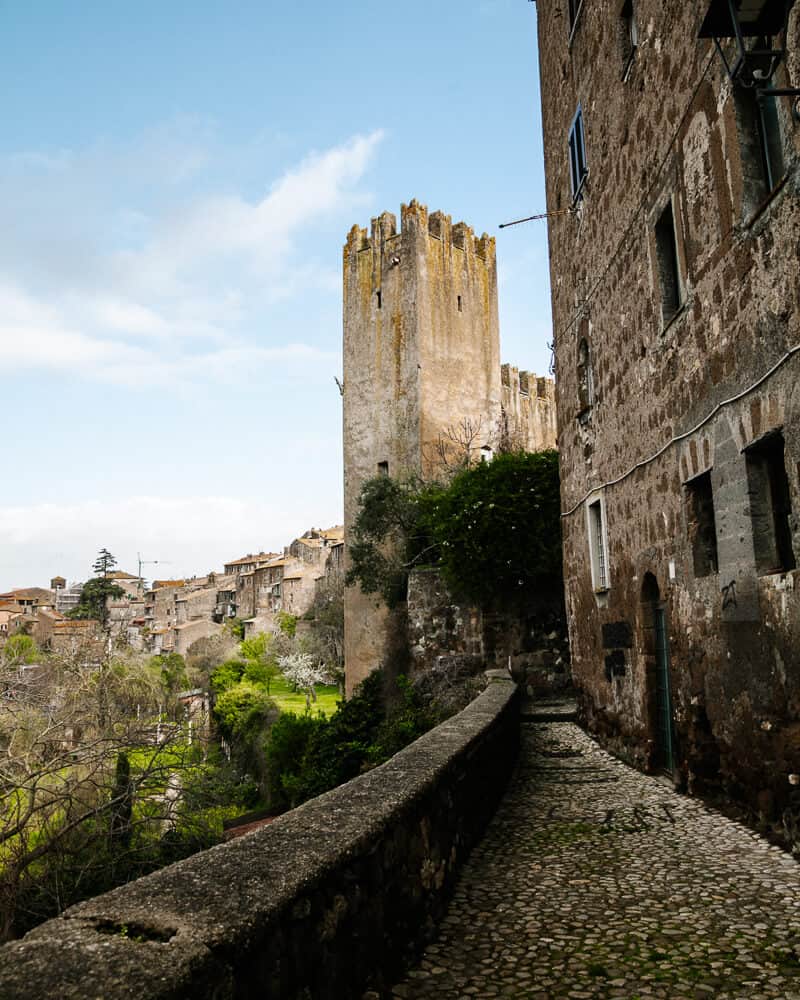
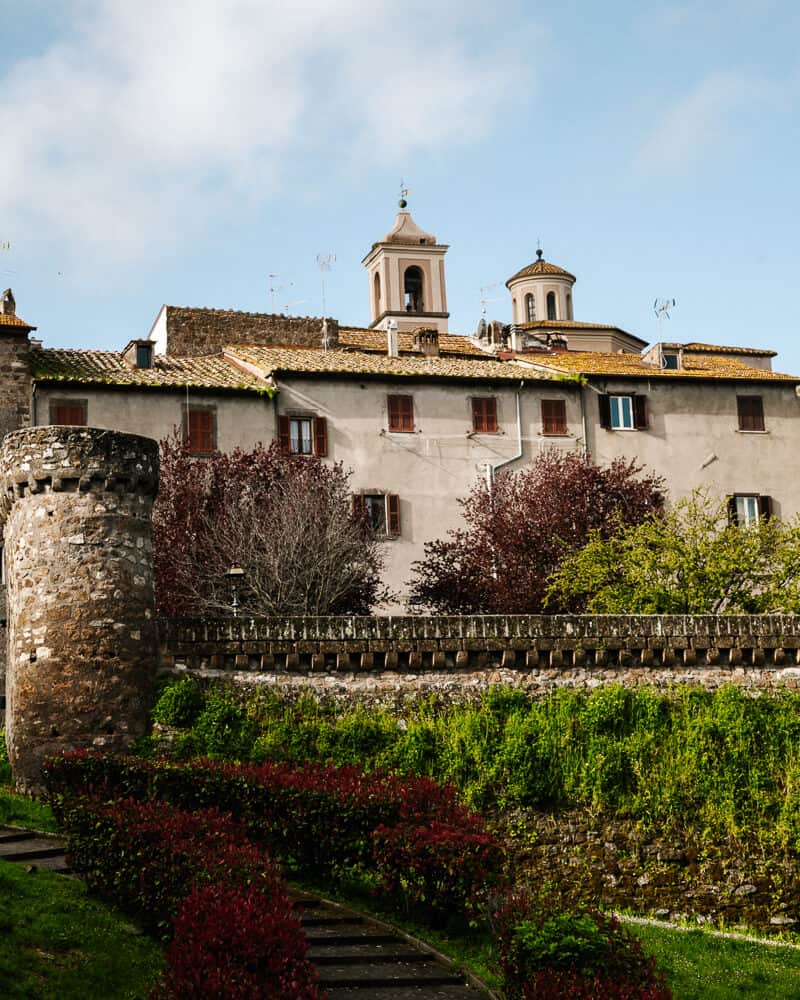
Satisfied, we arrive at our first hotel, Alberga de Bernadetta, and enjoy the Italian cuisine in an authentic setting in the family restaurant Il Pigno.
After a simple breakfast, today we have to put the first muscle pain aside and walk up the mountain with fresh energy. On the edge of Vetralla there is a large oak forest through which we walk for a good hour and a half. Here too, there are hardly any other hikers to be found. Except for a few people walking their dogs. We continue the way through fields with hazel trees and are amazed by the amount of them. On the way along the main road, we pass the small church Chiesa Madonna di Loreto, which is unfortunately closed.
One of the highlights during todays Via Francigena route are the Orlando Towers. Even though we read about them when we were preparing for the day, observing them makes us realize the history. The Orlando Towers are two burial monuments from Roman times, dating from the 1st century BC, including a bell tower that belonged to a Benedictine church.
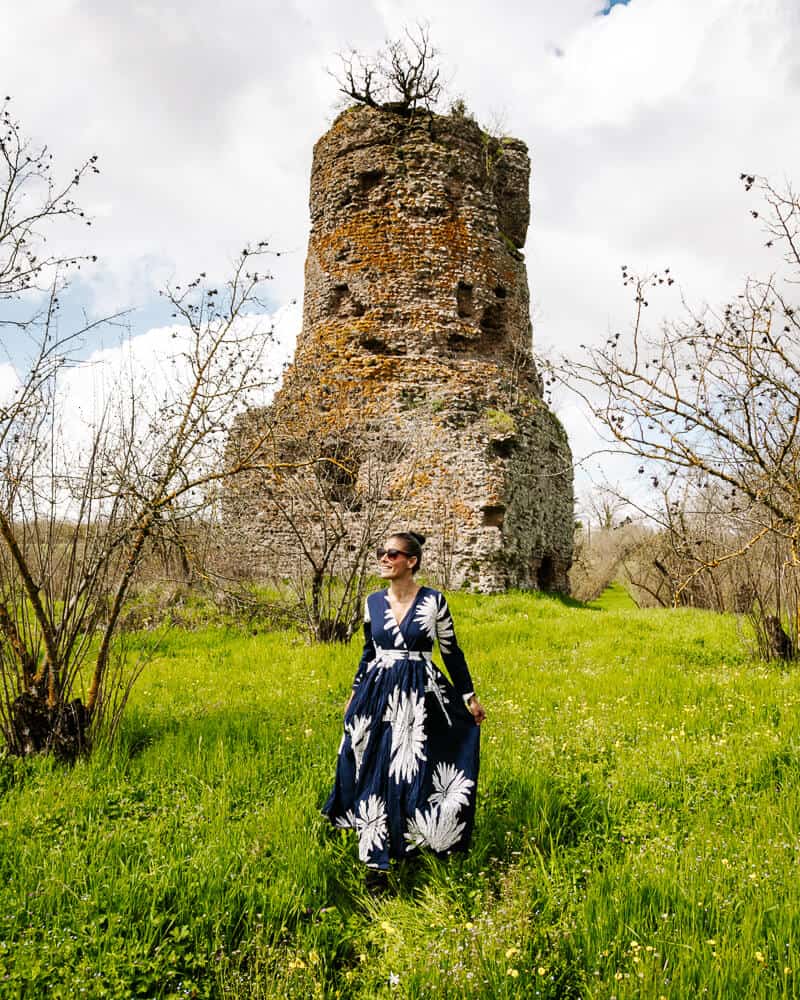
We see the ruins from a distance and because of the beautiful green surroundings and bright blue sky we cannot help but take a long break and enjoy the surroundings. Being the only visitors, makes us feel even more special. We take many pictures and put a note on our to-do list to learn more about it later on.
We continue our way and arrive in the medieval town Capranica. Here too it is so pieceful. But we did notice a few fellow walkers: a family of four and a hiker that walked towards us in the opposite direction. While we see our final destination of today, Sutri, far in the distance, we take our time for a pasta lunch, take pictures in Capranica with its countless alleys and houses that are surrounded by flowers. Afterwards we continue our trail back into nature.
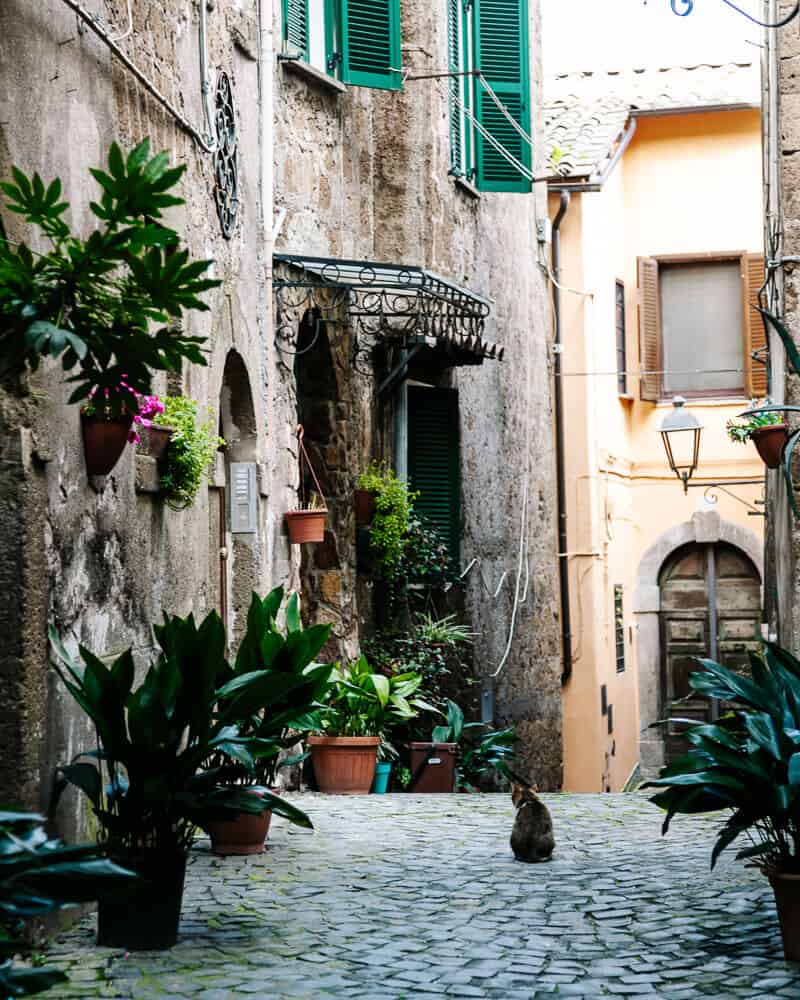
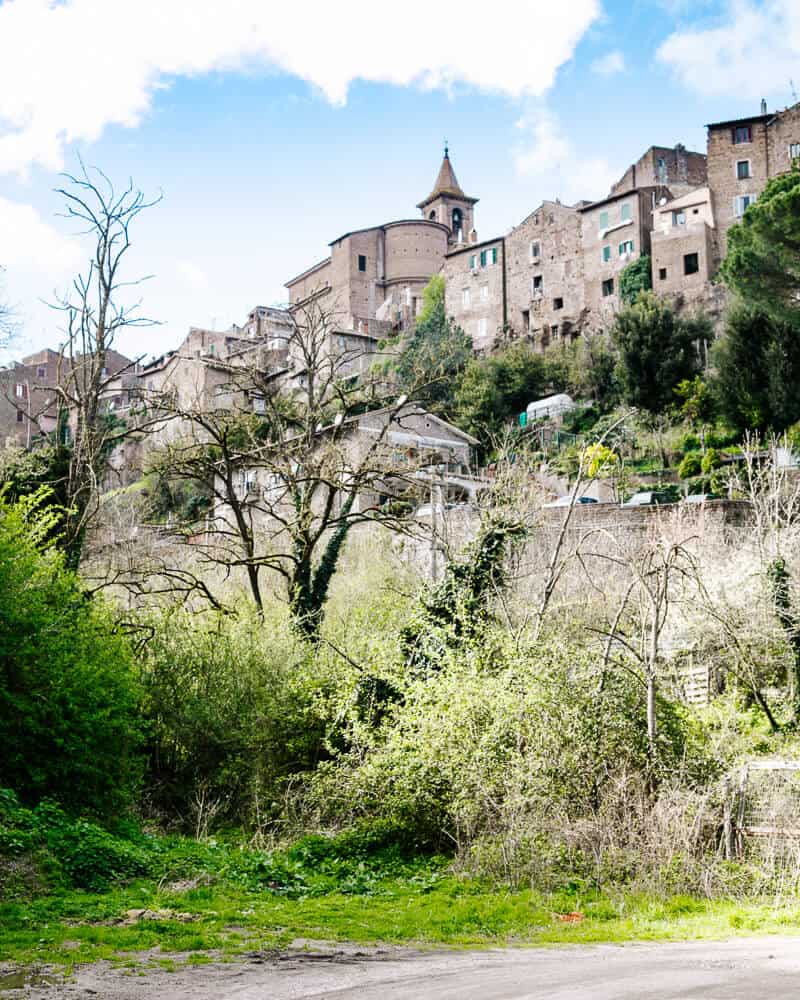
The last part of the Via Francigena route today is perhaps the most beautiful of the week. For a few hours we walk through a forest that feels almost tropical, over small paths and along a river. There are caves, waterfalls and countless lizards that scurry by. Because we don’t meet anyone for a few hours, we are completely absorbed in our own world. Until, out of nowhere, we suddenly see the town of Sutri in the distance. But it is still a few kilometers towards the ruins and the Amphitheater of Sutri, the place where we are picked up and taken to our overnight location, an agroturismo (farm in a rural area) outside the city.
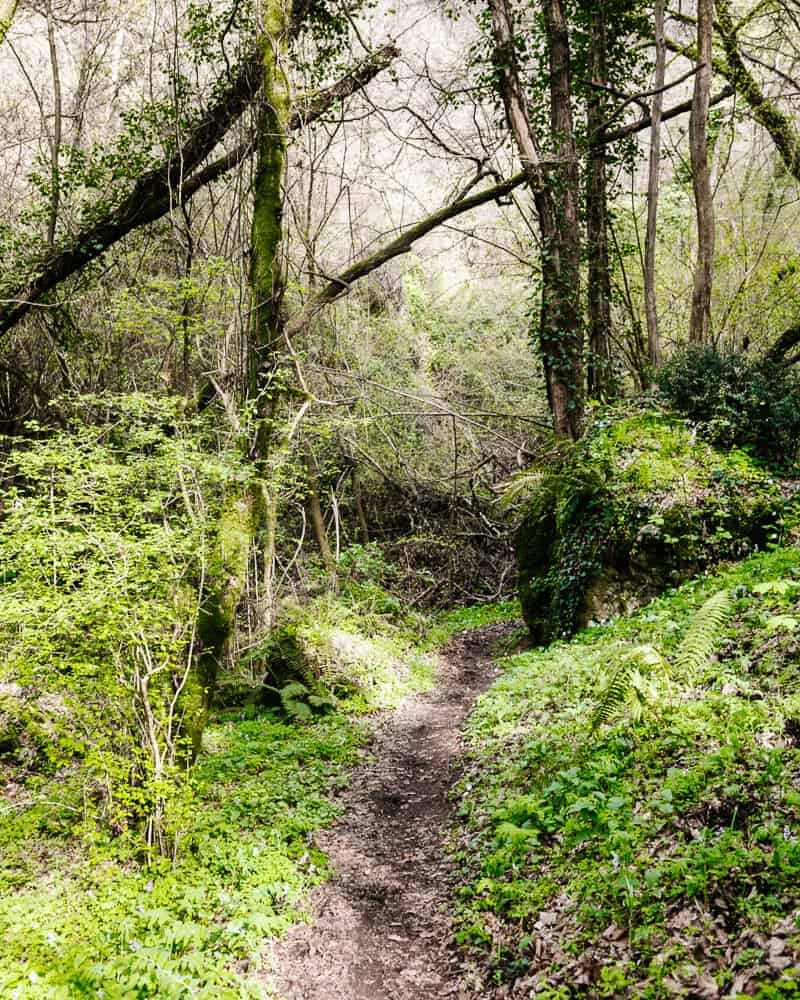
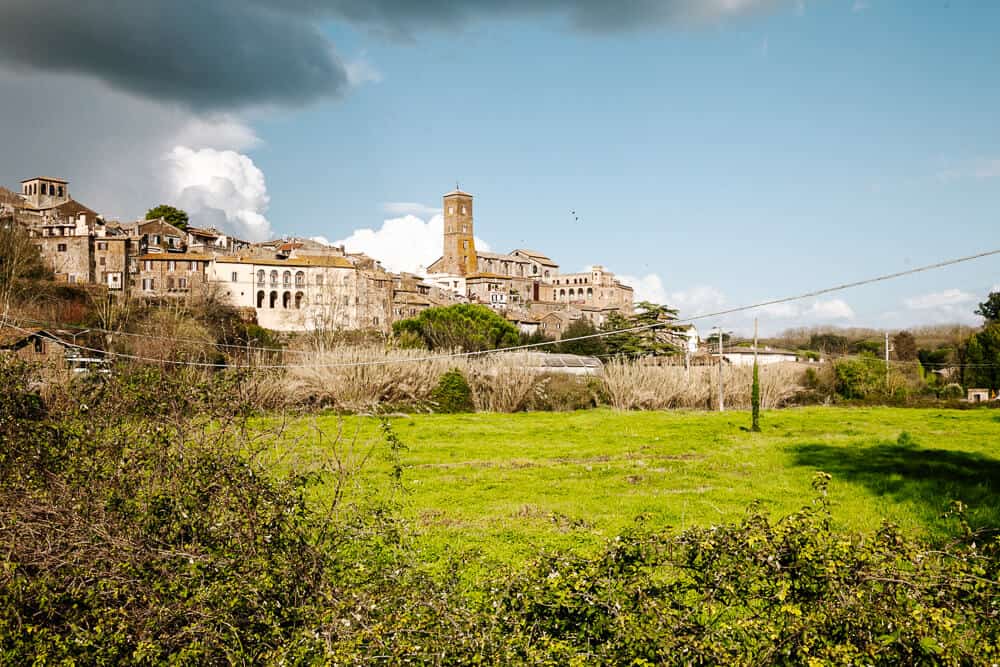
Please note that there is a good chance that the amphitheater of Sutri will be closed when you arrive. If you want to visit the amphitheater, it is recommended to check the opening times on the website and plan your day accordingly.
Today we have almost 27 kilometers of hiking on the program. From our Agriturismo hotel we walk back to the Via Francigena route. After all these days of walking we have become experts in finding the way and our muscles are also starting to get used to this type of activity, so we make a good start. Because we stayed just outside Sutri, we have also gained a few kilometers.
The Via Francigena route runs along peaceful paths with countless hazel trees. And before we know it we see the village of Monterosi. We hoped to be able to have lunch here, but because we have a faster pace than expected, we arrive well before lunchtime and can only go there for a drink and a short visit to the church. Fortunately we brought enough food and drinks for a nice picnic lunch between the fields, farms and horses.
One of the highlights of the Via Francigena route on day 4 are the Monte Gelato waterfalls, in the heart of the Treja valley. Several small waterfalls are part of a natural reserve and are connected by hiking trails. It is said to be busy with locals during the weekend, but today we are the only visitors again. We continue our way through yet another beautiful natural reserve and it is only birds and butterflies that accompany us on the rest of todays Via Francigena route.
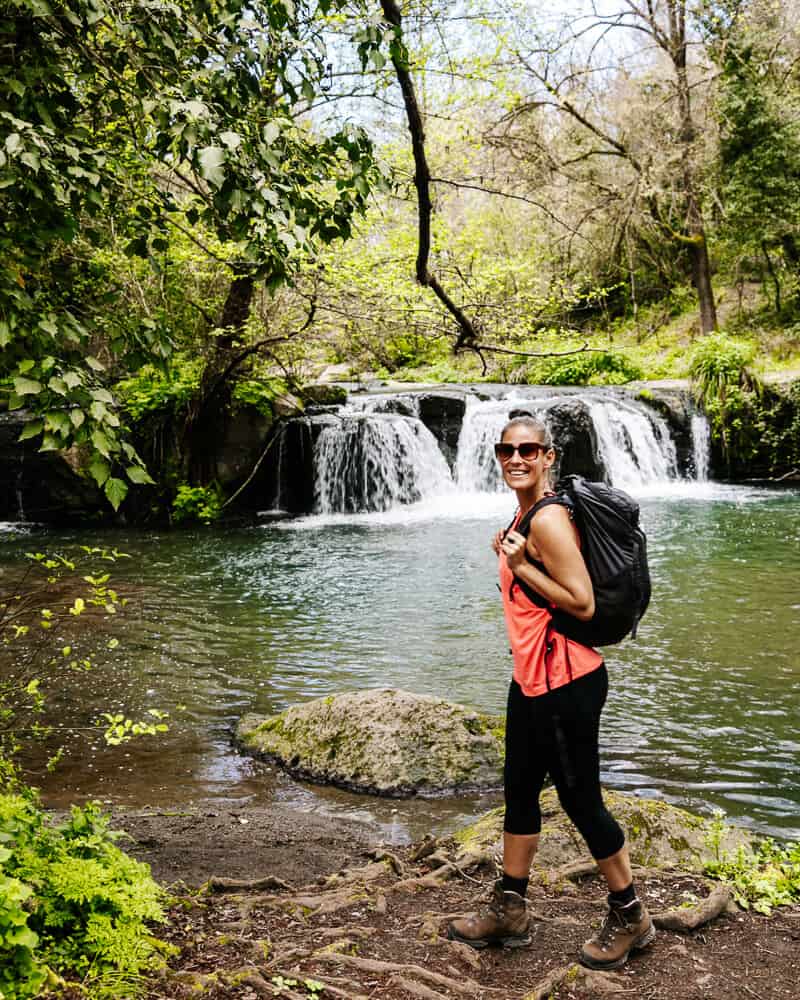
The last steps are the hardest and so it is today. After a few hours of walking we see Campagnano. But before we can enter the narrow alleys of the historic center, we have to climb a steep road, wich is not easy after a full day of hiking. As soon as we reach the old center, we are once again impressed by its beauty. We take a seat on the first terrace we come across and end the day with an amazing included dinner at hotel Begnini.
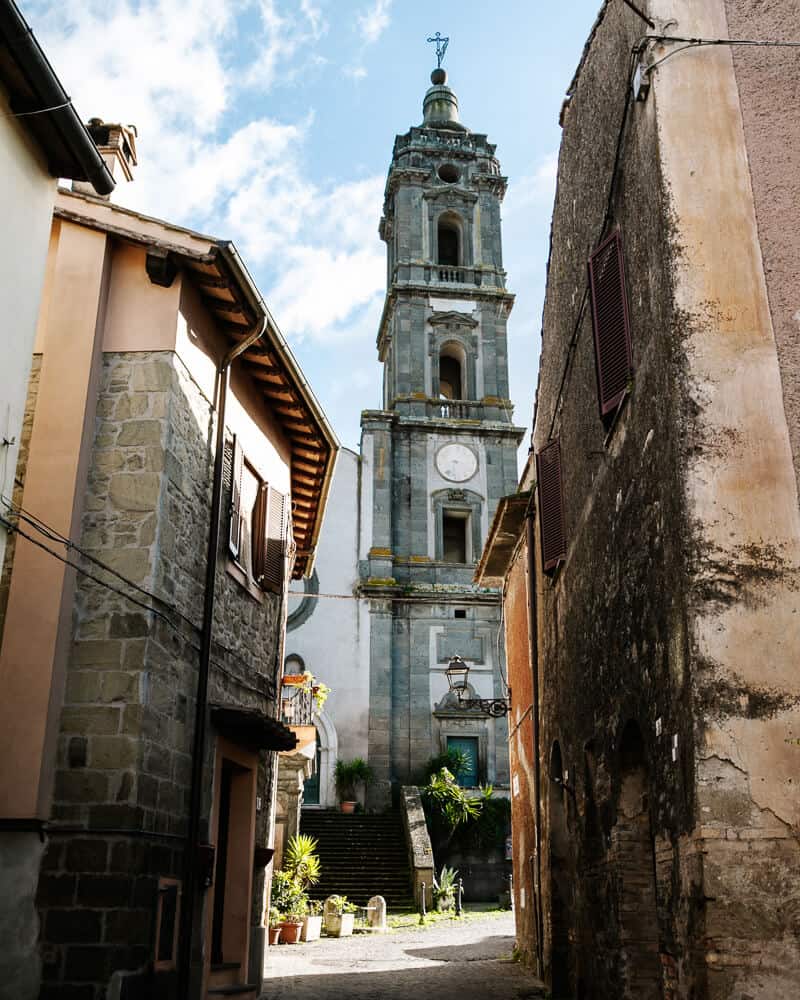
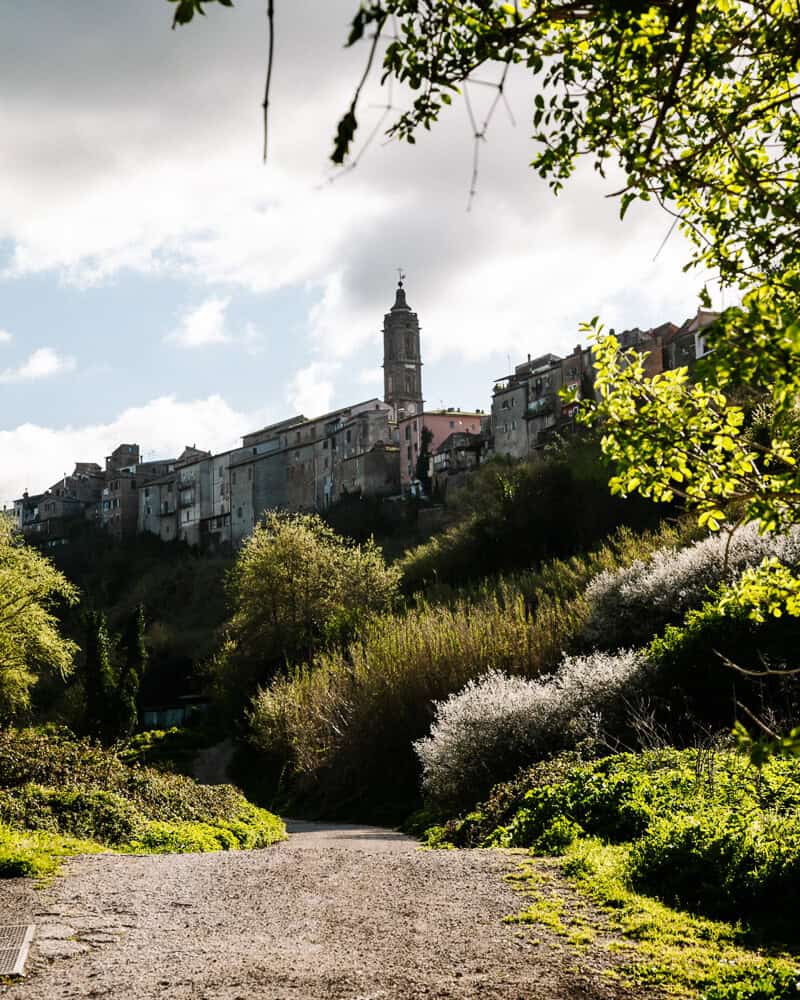
The day starts with a steep climb up the mountain. Fortunately, we are soon rewarded, because the views over the Lazio region are truly magnificent. Moreover, the sun is out without it being too hot. We realize how lucky we are.
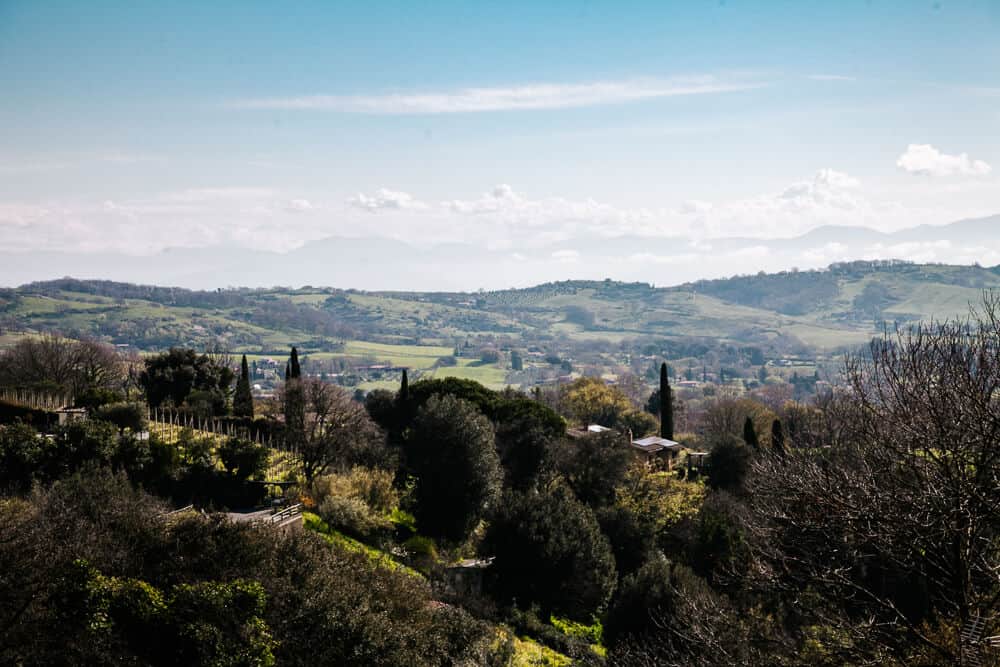
As soon as we enter the Parco Regionale di Veio, an area known for its landscapes and history, we make a stop at the church of Madonna del Sorbo for some photos. As we walk further into the park, we encounter more people, something rare during our trail. In this case it means we are approaching the town of Formello. But not before we climb another endless mountain. We wonder if the route today just contains many uphill parts or if our legs are starting to get tired. In Formello we take a small bite in the only local trattoria that is open around this morning time.
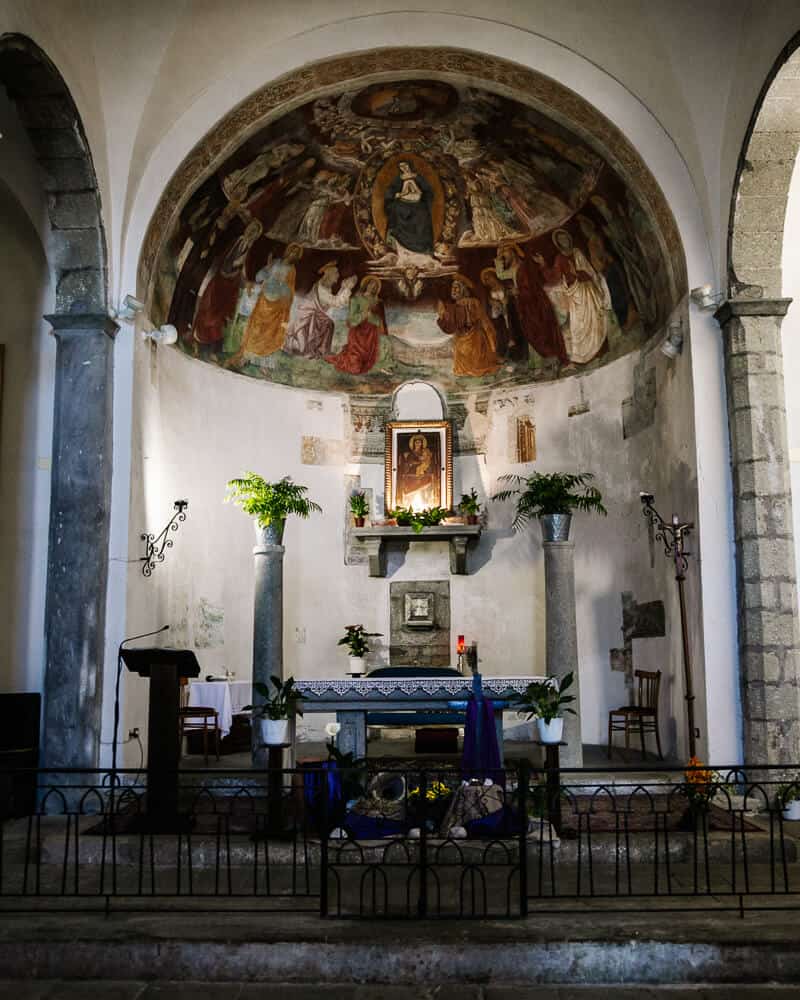
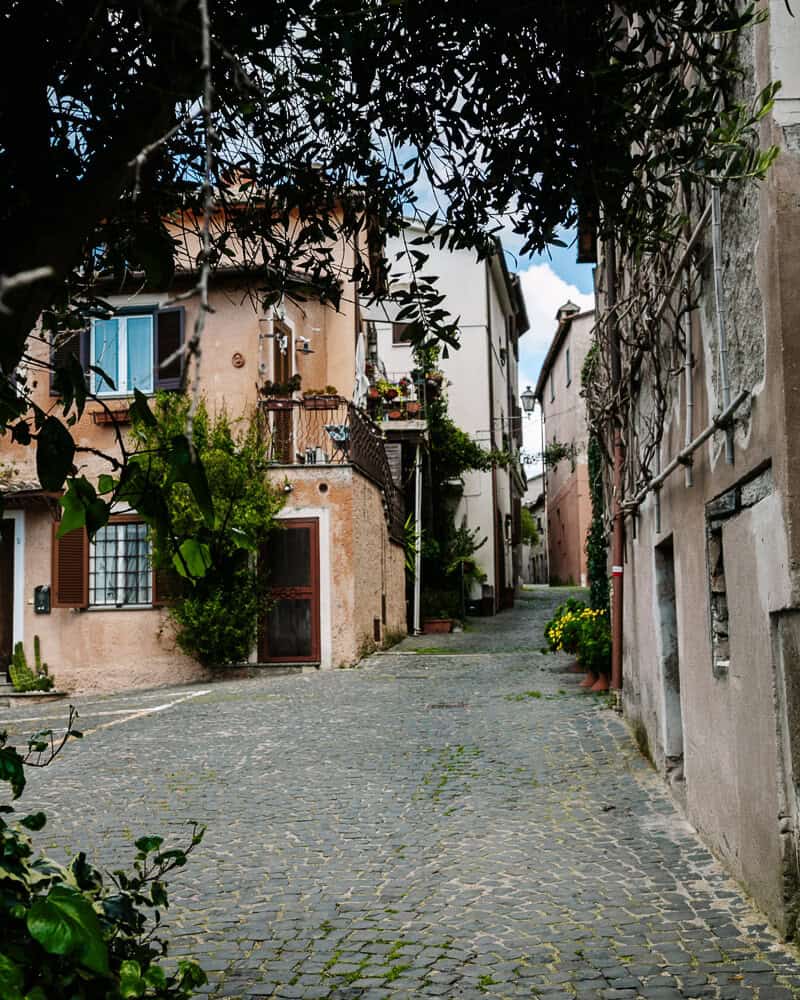
We leave Formello behind us and start, as the information tells us, on the long road to Isola Farnese. It all seems so close because Formello and Isola Farnese are only 10 kilometers apart by road. But of course, as a hiker you want a route through nature. And that’s what we get. We walk through meadows, forests, open fields and an area with ruins and tombs from the Etruscan period (eighth to first century BC).
Even though there is little to see because of the vegetation and undergrowth, the information signs make you stop and think about the history. We continue on another path that seems endless today and only after passing the waterfall Cascata della Mola di Formello we approach our overnight location.
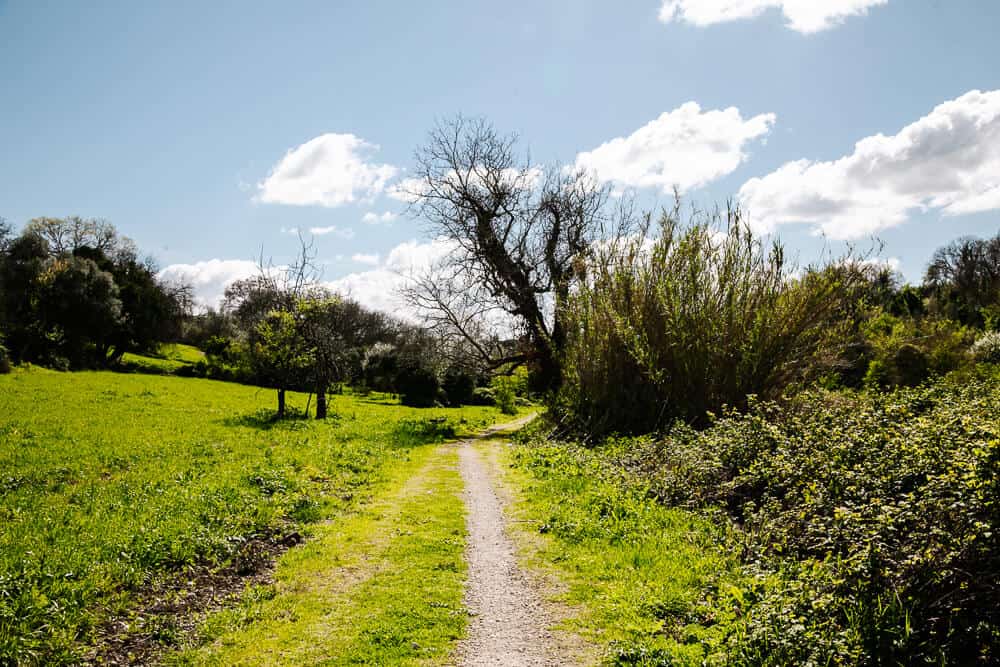
In Isola Farnese we walk a large part along the road to our hotel and realize that we have entered the inhabited world. Isola Farnese is a half hour drive from Rome and feels much more urban. Tonight we will dine at La Fattoria di Clotilde, before we spend our last night during the Via Francigena route.
And today is the day, it is the day that we will arrive in Rome by foot. And just like with the Camino de Santiago, this makes us so excited. Unfortunately, a large part of today’s Via Francigena route runs along the road with a lot of traffic, the former Roman road, Via Cassia. Once again a realization that we are approaching our final destination.
Unfortunately, the Via Francigena route is currently being diverted and the Monte Mario Park and Mons Gaudii or Mone della Gioia (Hill of Joy), near Rome, have been closed for a while due to fallen trees. This is the place where pilgrims used to see St. Peter’s Church for the first time. That view must have been so special, after weeks and sometimes months of walking.

After some research we find an alternative viewpoint called Parco di Monte Ciocci. It is a small detour but nothing is more beautiful than ending the Via Francigena route with a view of Rome. And it is worth it: From the park we see the Vatican and the towers of St. Peter’s Church. We take lots of photos and secretly think it is a bit of a shame that our walking adventure is over.
After this we walk down the stairs and into busy Rome. Despite the strange feeling of arriving in a big city with your backpack and walking stick, we walk straight to St. Peter’s Square and the Vatican. It is a big change seeing all these crowds after spending time in all these perfect medieval towns without a single tourist around.
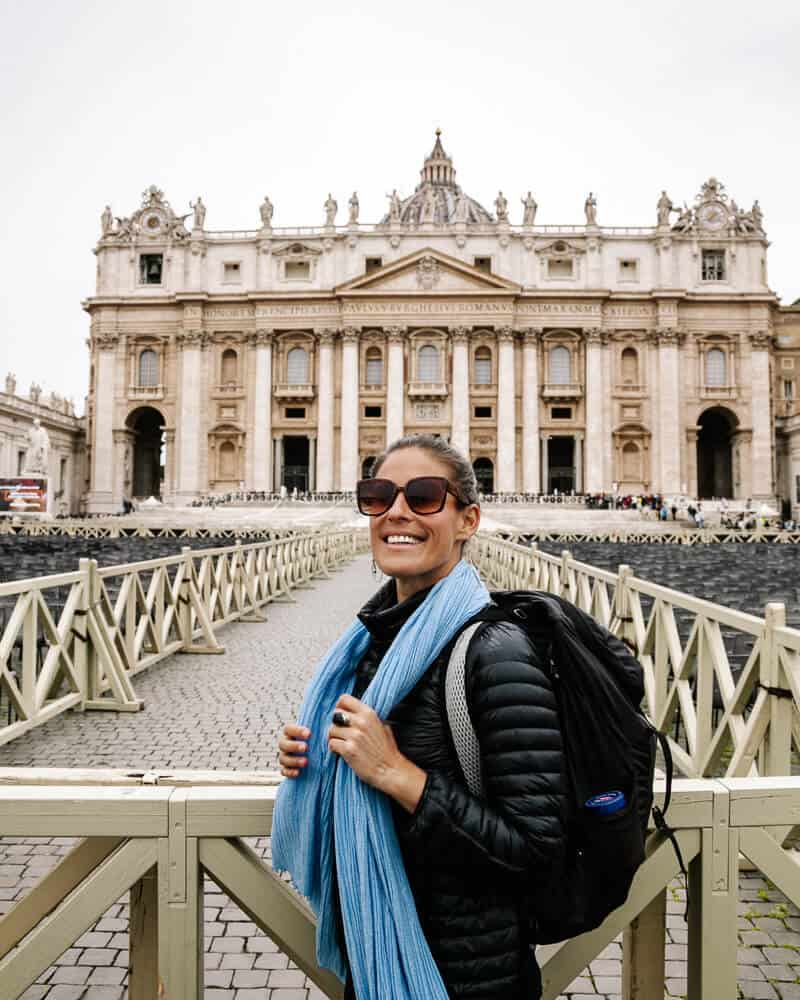
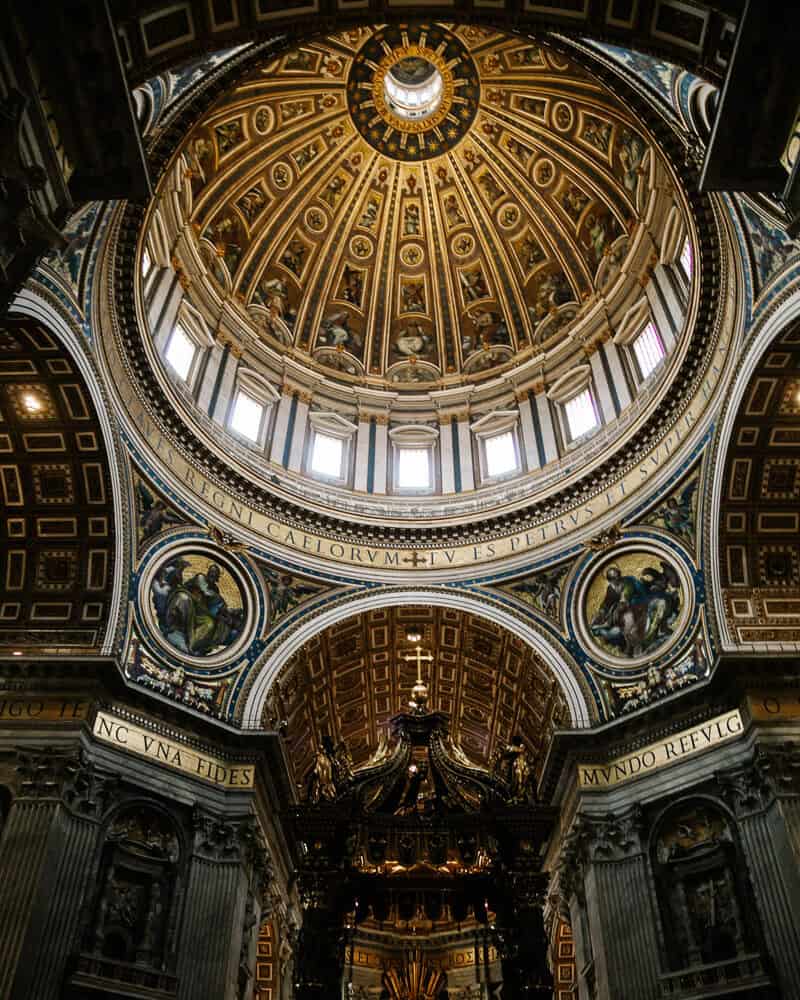
After several rounds and being sent back and forth, we understand that we have to be in St. Peter’s Church itself for our official certificate. And that is indeed correct, at the cloakroom there is a volunteer who looks at our pilgrim passport and then hands us the certificate. After a visit to St. Peter’s Basilica, we take a seat on the terrace to celebrate our journey. We have made it again.
When you complete the Via Francigena route, you can be proud of yourself. And there is hardly a greater reward than eating, drinking and enjoying yourself in Rome. So make sure that you stay in Rome for at least one or two nights before you fly back home. Rome is a city where you can’t get enough, because on every street corner there is another impressive building to admire. And even though you may not feel like walking so much anymore, there are plenty of nice neighborhoods with terraces where you can enjoy the Roman and Italian atmosphere in peace.
There are several ways to plan your Camino Francigena. One of the best options is to use the services of a Camino planner such as Follow the Camino , who also put together tailor-made routes to Santiago de Compostela. Based on your preferences, they help you plan a custom made Via Francigena itinerary, book accommodations, including meals, provide detailed route information with maps, luggage transfers, a lot of tips and tricks and you can even track your route through their App available on iOS and Android. After booking, you enter your online environment through Follow the Camino’s trip portal and are guided through all preparations from A to Z.
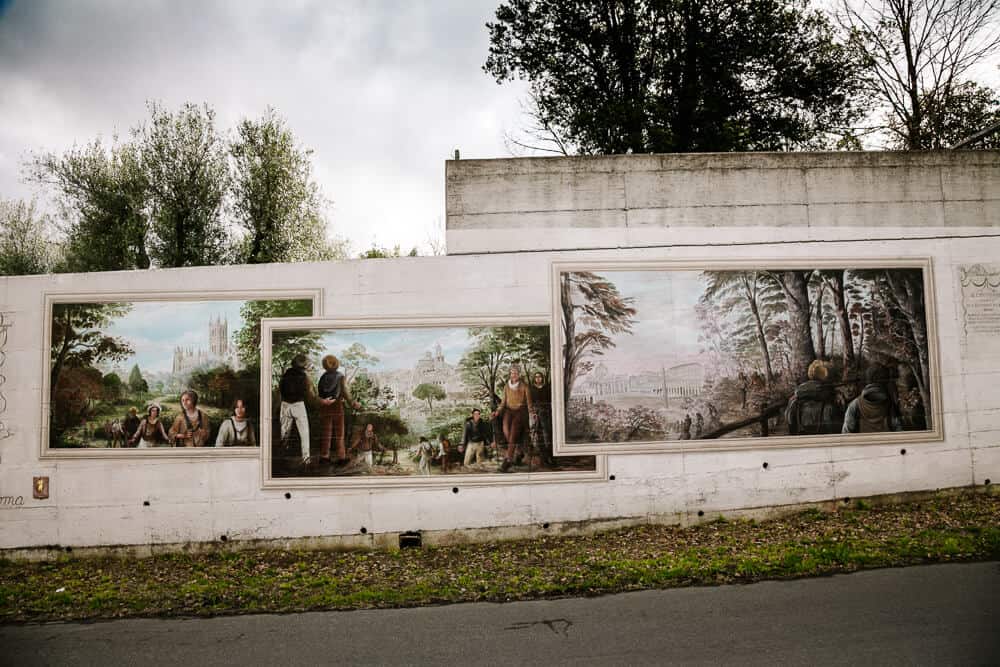
Do you find it interesting to explore this historic pilgrimage route to Rome with a guide and learn more about the history along the way? At Follow the Camino you can also opt for a Via Francigena Guided tour package.
Hoe gaat het allemaal in zijn werk? Moet je trainen? Wat moet je meenemen? Na het boeken bij Follow the Camino kom je in je eigen online omgeving terecht. Weken van tevoren krijg je al berichten en informatie over jouw Via Francigena route zodat de voorpret kan beginnen. Beetje bij beetje wordt alles duidelijk, waardoor je goed voorbereid op pad gaat.
During the last stage of the Via Francigena from Viterbo to Rome you walk an average of 22 kilometers per day. It is not a difficult walk, but the days are long. But you need to enjoy walking and have a good basic level of fitness. And of course it is a matter of perseverance at times. Especially because after a few days you will feel the fatigue in your legs. Honestly, I did not train myself for the walk, but I am used to go on longer walks more frequently. Walking the Via Francigena from Viterbo to Rome is accessible, but physical and mental preparation is important to get the most out of your walk.
In contrast to the yellow arrows and scallop shells that are so recognizable for the Camino de Santiago route, the signs for the Via Francigena are a little less clear. But they are there. There are clear signs with Via Francigena on them, stickers with red/white stripes, arrows and drawings of walkers and all kinds of variations. You can find them on trees, poles, and under viaducts. It takes a while, but after a few hours you will be completely aware of them.
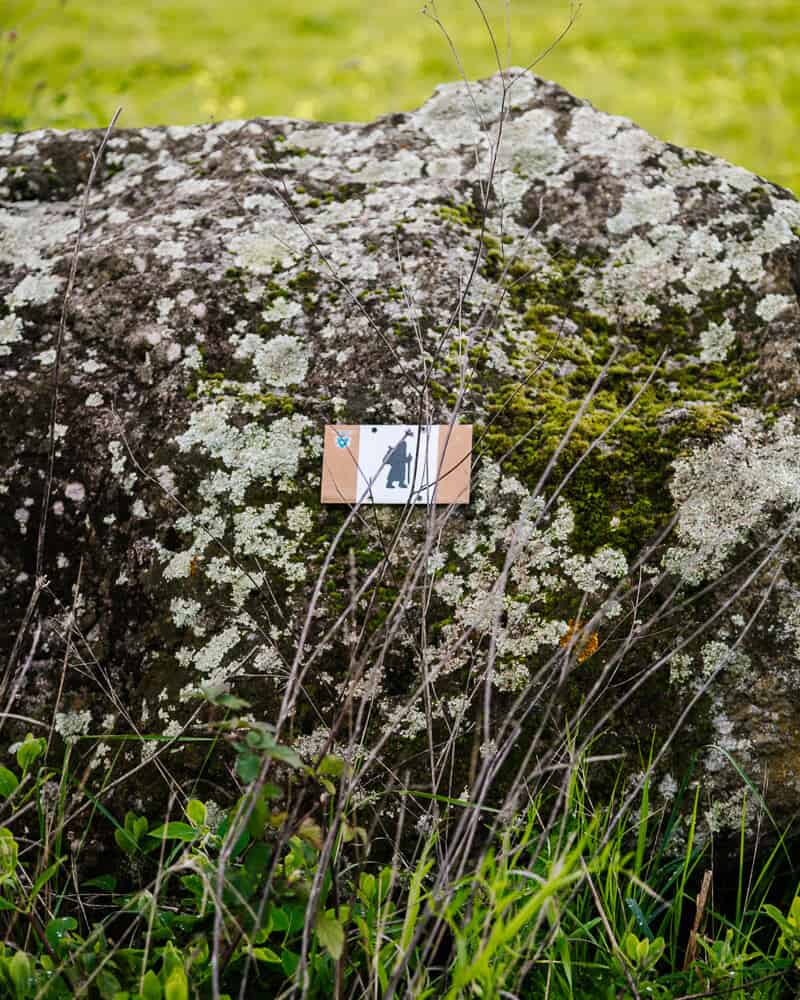
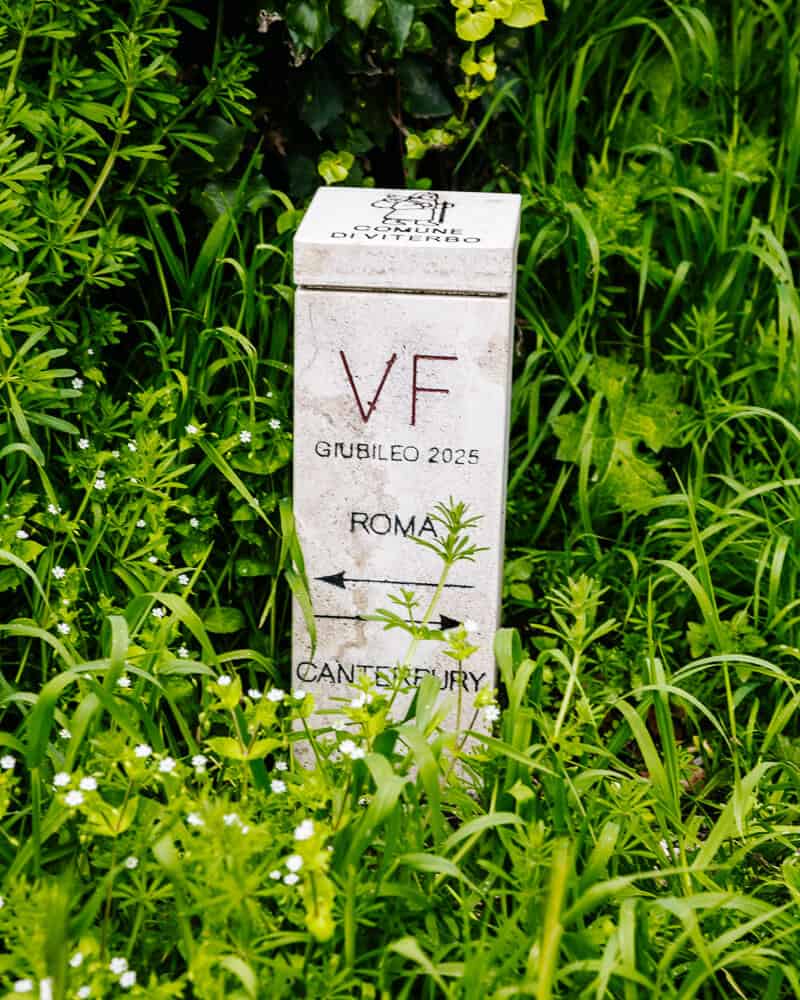
However, it is important to delve into the route in advance, so that you know what to expect and can make a plan. Follow the Camino also provides you with a travel guide with useful background information. You can also download the official Via Francigena app, which provides you with even more information
When you read about the Camino de Santiago and the Via Francigena, you will also read about the pilgrim passport, the credential del peregrino, a special booklet in which you can collect stamps every day. You can get stamps at various locations along the pilgrimage route such as in churches, restaurants and hotels. You need at least two stamps per day to collect your official official pilgrim certificate upon arrival at St. Peter’s Church.
Not only is the certificate a nice souvenir, but finding the stamps during the pilgrimage walk to Rome is also a nice activity. However, the number of places for stamps is limited during the Via Francigena walk, so you have to seize every opportunity if you want to fill your stamp booklet.
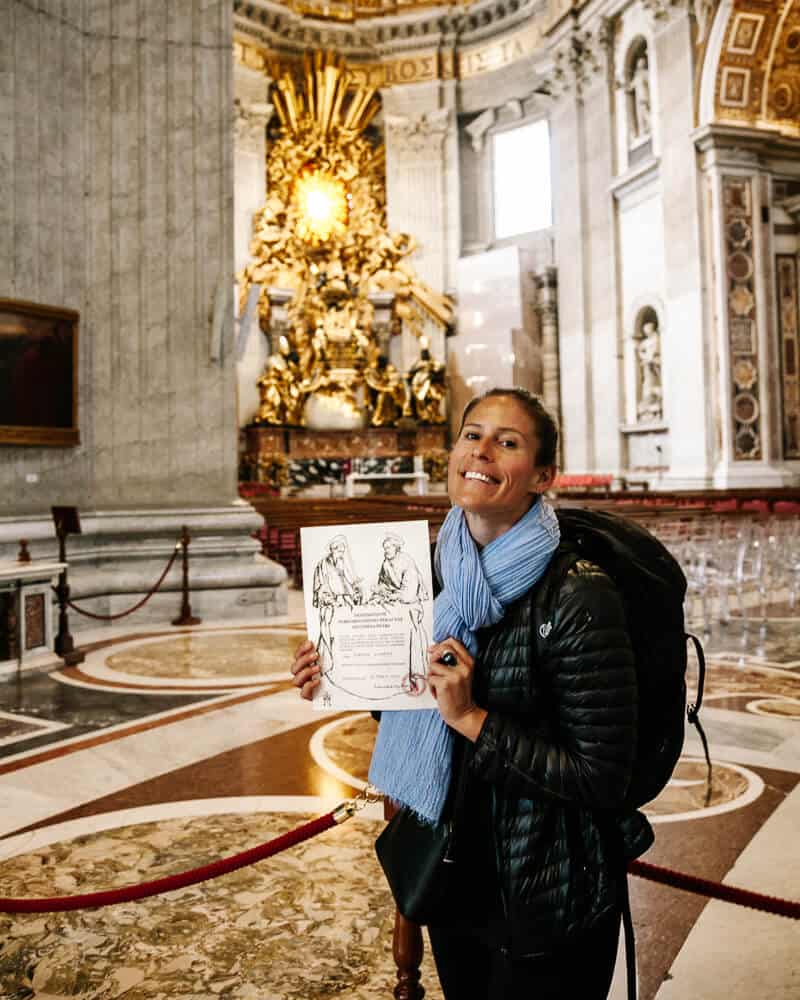
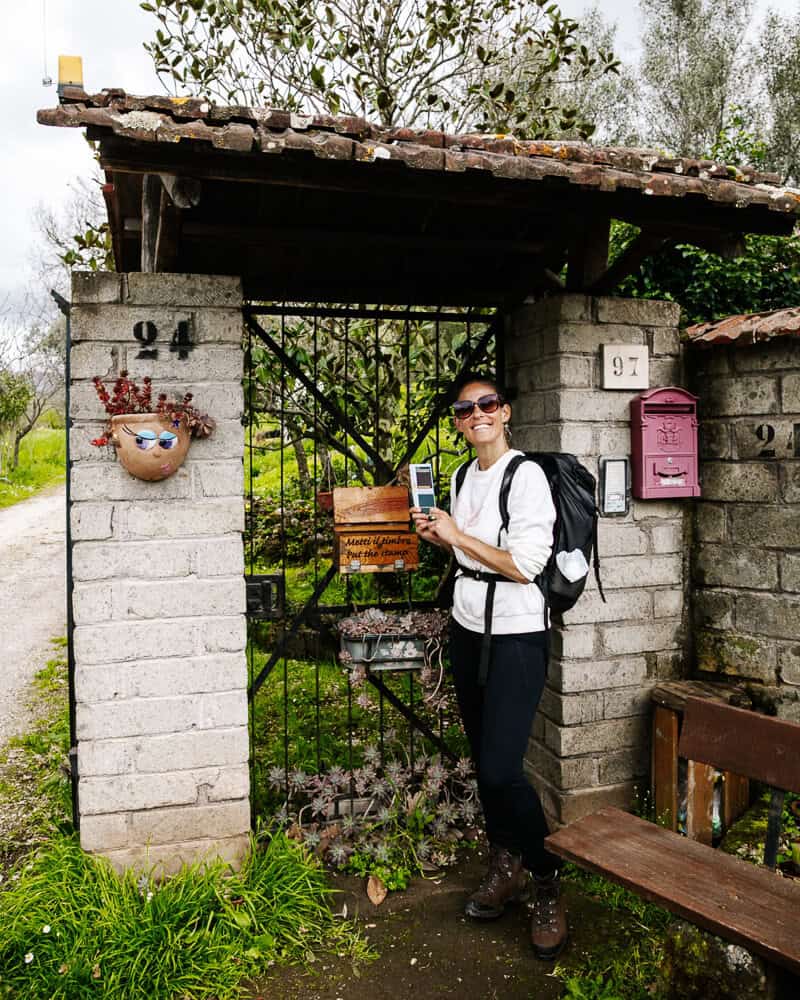
The Camino de Santiago is perhaps one of the most famous walking routes in Europe, but it is also one of the longest. At least, if you plan to walk one of the full routes. But did you know that you can also walk just the last 100 km to Santiago de Compostela? This pilgrimage route along the Camino Frances takes you in 5 days from Sarria to Santiago de Compostela, through Galicia in northern Spain. In the next article, I’ll tell you everything you need to know about this Camino de Santiago route, including a day-to-day description and how to best organize your Camino.
Follow the Camino his the original Camino tour operator. They have been in the business since 2006 and have driven thousands of pilgrims in the past years to Santiago de Compostela and Rome. With their expertise, they help you to organize your tailor-made Camino. So that you only have to concentrate on walking to Santiago de Compostela and Rome. Based on your needs, a package consists of the following components:
Do you want to know about about Follow the Camino? Check out the website.
Want to know more about the Camino de Santiago and the Via Francigena pilgrimage route to Rome? I have now walked the last 100 kilometers of the Camino de Santiago and Via Francigena. In the following articles you can read more about my experiences and find tips and inspiration for your camino.
Disclaimer: I was invited to hike the Via Francigena by Follow the Camino, but this review is based on my personal view and is independent from the invitation. This article may contain affiliate links. If you purchase something using one of our links, we may receive a commission at no extra cost to you, which helps us keep this blog alive. Thank you for your support! Please see our disclosures for more information.